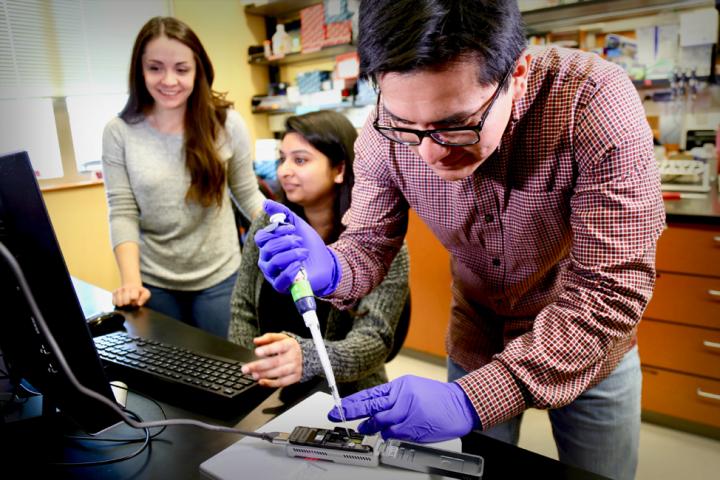
Credit: Alex Crookshanks for Virginia Tech
When emerging plant pathogens go undetected, they have the potential to negatively affect food industries, conservation efforts, and even human health. And, just like emerging human pathogens, such as the 2019 novel Coronavirus, emerging plant pathogens need to be diagnosed as soon as possible to prevent them from spreading.
Genetic sequencing technologies are powerful tools that are used for the early detection and precise identification of pathogens; they have shown great improvement over the past 20 years. Using these novel technologies, scientists can identify pathogens down to their distinct DNA sequences, without the time- and labor-intensive need to grow pathogens in the lab.
Scientists at Virginia Tech are taking advantage of this technological revolution by developing a way to apply these technologies to identifying diseases in crops.
“We truly try to take advantage of the DNA sequencing revolution. However, it’s not enough to just sequence DNA. What we focus on in the lab is to combine the power of DNA sequencing with the power of new computer algorithms to interpret the DNA sequences to precisely and quickly identify these pathogens,” said Boris Vinatzer, professor in the School of Plant and Environmental Sciences in the College of Agriculture and Life Sciences and an affiliated faculty member of the Fralin Life Sciences Institute.
Vinatzer recently published his findings in the journal Phytopathology, along with his graduate students and collaborators Song Li, an assistant professor in the School of Plant and Environmental Sciences, and Lenwood Heath, a professor of the Department of Computer Science in the College of Engineering.
For this study, Vinatzer’s team wanted to determine if an Oxford Nanopore Sequencing MinION device and a combination of different bioinformatic programs and sequence databases would be successful in identifying bacterial pathogens down to the exact outbreak strain.
When tested on tomato plants grown on the Eastern Shore of Virginia, the MinION device recognized Xanthomonas perforans, a proteobacteria responsible for bacterial leaf spot in tomato plants, as the pathogen in question.
What was even more impressive is the fact that the team was able to make their identifications down to the strain level. Strain identification poses a serious challenge to scientists because strains can be difficult to distinguish from one another. Without the proper technology and databases, new strains could be misidentified and the diseases they cause go untreated.
“If you want to know if it’s a new strain that is causing a disease outbreak, you need to fine-tune your method. We have successfully done that. In fact, we didn’t just find out that the pathogen that causes the disease in Virginia tomatoes belongs to the species X. perforans, we also identified which group of strains within the species it belongs to. Luckily, in this case, we found that the pathogen belongs to a group of strains that is common in Florida that has been circulating in the U.S. for years. Therefore, eradication will not be necessary,” said Vinatzer.
In the past, scientists would have to run a separate test for every possible pathogen that could be in a sample. With new sequencing technologies, just one test can be used to identify anything and everything that is in a plant sample – including bacteria, fungi, and viruses.
After the DNA sequences are obtained, scientists must then feed sequence data into a database to compare them with reference sequences, which will tell them exactly what pathogen they are facing. Since databases can be accessed worldwide, local scientists can easily identify emerging pathogens by using data from where the pathogen has already been established.
However, at the time of the study, a comprehensive database that could precisely identify plant pathogens did not exist. Therefore, Vinatzer and Heath decided to take matters into their own hands and create their own database, LINbase. This database is unique in its use of Life Identification Numbers (LINs), which are like GPS coordinates. Each bacterial isolate has a number that scientists can reference and then use to classify and identify bacterial genome sequences to the strain level.
The lab’s ultimate goal is to improve and then transfer their new sequencing technology and computer algorithms to the Plant Disease Clinic at Virginia Tech, which provides plant disease diagnostic services to farmers, nurseries, and homeowners as part of Virginia Cooperative Extension. Eventually, the lab hopes to extend its reach to other plant disease clinics from around the world.
The technology could eventually be deployed in the field, along with automated sampling devices from the SmartFarm Innovation Network, an initiative of Virginia Tech’s College of Agriculture and Life Sciences, to develop and deploy innovative technologies in food, agricultural, and natural resources production systems in Virginia.
“The Oxford Nanopore Sequencing MinION device is one of those technologies that will really have an impact and I think it will save growers a lot of money. By being fast and more precise in identifying diseases, growers can intervene early and manage diseases effectively, thus reducing losses in crop yield and quality,” said Vinatzer.
With the success of their recent study, the lab’s next steps involve further reducing the amount of time that it takes for pathogen identification. The goal is to decrease the time that it takes from receiving a plant sample to identifying the pathogen strain from days to hours.
###
Vinatzer, Heath, and Li, would like to acknowledge seed funding from the cyberbiosecurity initiative, led by the College of Agriculture and Life Sciences. The Vinatzer lab also uses the MinION sequencer as part of a larger NSF-funded project that focuses on bacteria in precipitation.
Media Contact
Kristin Rose
[email protected]
540-231-6614
Related Journal Article
http://dx.




